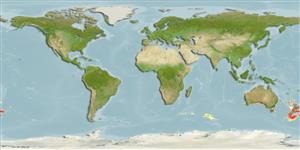Teleostei (teleosts) >
Gadiformes (Cods) >
Macrouridae (Grenadiers or rattails)
Etymology: Coelorinchus: Greek, koilos = a hollow + Greek, rhyngchos = jaw (Ref. 45335).
Environment: milieu / climate zone / depth range / distribution range
Ecology
Marine; bathydemersal; depth range 300 - 800 m (Ref. 26363). Deep-water
Southwest Pacific: Australia (New South Wales to Victoria and Tasmania) and New Zealand.
Size / Weight / Age
Maturity: Lm ? range ? - ? cm
Max length : 28.5 cm TL male/unsexed; (Ref. 26363)
Dorsal spines (total): 2. Several faint dark dorsal saddle marks on the posterior half of the body; pale intervening marks about the width of two scale rows; naked ventral surface of head and lower jaw (some with 1-3 scales beside articulation of lower jaw); dorsal anterior snout with naked triangular areas; naked below nostrils to suborbital ridge; large well-developed oval dermal window of light organ separated from anus by 2-3 rows of scales; lateral and medial processes of nasal bone not continuous (Ref. 26363). Resembles Caelorinchus maurofasciatus, C. mystax, C. bollonsi, C. cookianus, and C. fasciatus. Differs from C. mystax, C. bollonsi, and C. fasciatus in numbers of pyloric caeca (22-28 versus 111-115, 27-38, 12-23, respectively) in addition to other characters (Ref. 26363). C. parvifasciatus has similar numbers of pyloric caeca to C. maurofasciatus and C. cookianus but differs in having saddle markings only on the posterior half of the body (Ref. 26363).
A benthic species found on the continental slope (Ref. 75154).
Life cycle and mating behavior
Maturities | Reproduction | Spawnings | Egg(s) | Fecundities | Larvae
McMillan, P.J. and C.D. Paulin, 1993. Description of nine new species of rattails of the genus Caelorinchus (Pisces, Macrouridae) from New Zealand. Copeia 1993(3):819-840. (Ref. 26363)
IUCN Red List Status (Ref. 130435)
Threat to humans
Harmless
Human uses
Tools
Special reports
Download XML
Internet sources
Estimates based on models
Preferred temperature (Ref.
123201): 6.7 - 11.2, mean 8.5 °C (based on 140 cells).
Phylogenetic diversity index (Ref.
82804): PD
50 = 0.5000 [Uniqueness, from 0.5 = low to 2.0 = high].
Bayesian length-weight: a=0.00251 (0.00128 - 0.00492), b=3.19 (3.03 - 3.35), in cm total length, based on LWR estimates for this Genus-body shape (Ref.
93245).
Trophic level (Ref.
69278): 3.5 ±0.5 se; based on size and trophs of closest relatives
Resilience (Ref.
120179): Medium, minimum population doubling time 1.4 - 4.4 years (Preliminary K or Fecundity.).
Fishing Vulnerability (Ref.
59153): Low vulnerability (19 of 100).
